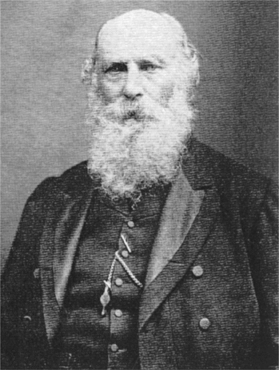atoms].20
Maxwell was specially interested in molecules for many philosophical purposes. He recognised the significance of there existing populations of identical building blocks for all the material bodies we see around us. If we take any piece of pure iron it will be composed of a collection of identical iron molecules. The fact that these molecules appear to be identical is a remarkable feature of the world. Maxwell contrasted this invariance with the changeability and evolution of living things predicted by Charles Darwin's theory of evolution by natural selection. Maxwell pointed to the molecules of Nature as entities that were not subject to selection, adaptation or mutation. His challenge was to find a way to exploit this immutability and universality in the way that we define our units of measurement. In this way we would be able to take a step away from the bias introduced by the imperatives of human convenience towards the deep invariances of physical reality.
In 1905 the red light emitted by hot cadmium atoms21 was first used as a standard against which to define a unit of length called the ångstrom (denoted by 1å and equal to 10–10 metre). One wavelength of the cadmium light was equal to 6438.4696 å. This was a key step because for the first time it defined a standard of length in terms of a universally constant feature of Nature. The wavelength of the light emitted by cadmium22 is fixed by the constants of Nature alone. If we wanted to tell an extraterrestrial physicist our size, we could do it by saying what we mean by 18 billion wavelengths of red cadmium light.23
A BRILLIANT IDEA!
‘“Where did the matter come from?”
“What is the difference? …The secret of the universe is apathy. The earth, the sun, the rocks, they're all indifferent, and this is a kind of passive force. Perhaps indifference and gravitation are the same.”’
Isaac Bashevis Singer24
In 1874, an unusual Irish physicist called George Johnstone Stoney found himself having to make sense of the Babel of practical units. He had been invited to deliver a lecture on units of measurement at the annual meeting of the British Association for the Advancement of Science in Belfast.25 This annual meeting still exists today but is now devoted to showcasing the developments in science for the general public, the Press and young people. But in Stoney's day it was the foremost science conference in the world, a place where great discoveries would be made public and the Press would report on great debates between leading scientists and commentators. Today there are so many specialised scientific conferences, workshops, meetings, discussions, panel discussions and round tables that there is no longer any place for a meeting that covers all of science at a technical level – it would be impossibly big, impossibly lengthy, and well nigh unintelligible to most of the participants much of the time.
Stoney was an eccentric and original thinker. He was the first person to show how to deduce whether or not other planets in the solar system possessed a gaseous atmosphere, like the Earth, by calculating whether their surface gravity was strong enough to hold on to one. But his real passion was reserved for his most treasured idea – the ‘electron’. Stoney had deduced that there must exist a basic ingredient of electric charge. By studying Michael Faraday's experiments on electrolysis Stoney had even predicted27 what its value must be – a prediction subsequently confirmed by J.J. Thomson who discovered the electron in Cambridge in 189728 and announced his discovery to the Royal Institution on 30 April. To this basic quota of electric charge Stoney eventually gave the name ‘electron’ and the symbol E in 189129 (after first calling it30 the ‘electrine’ in 1874) and he never missed an opportunity to publicise its properties and potential benefits for science.31

Figure 2.3 The Irish physicist George Johnstone Stoney (1826–1911).26
Stoney was also an older distant cousin of the famous mathematician, computer scientist and code-breaker, Alan Turing, whose mother recalled childhood memories of the unusual uncle the children called ‘electron Stoney’.32 He was also the uncle of George FitzGerald, now famous for proposing the Lorentz-FitzGerald contraction of length, a phenomenon that was eventually understood within the context of Einstein's special theory of relativity. Stoney was also a practical man and worked for two years for the Earl of Rosse constructing sensitive optical instruments for his private observatory at Birr Castle before becoming Professor of Natural Philosophy at Queen's College Galway in 1850. After his retirement he moved to Hornsey in north London and continued publishing a steady stream of papers in the Royal Dublin Society's scientific journal. It is hard to find an issue that doesnz't contain a paper under his name, on every conceivable subject, we find everything from time travel to how bicycles stay upright.
Stoney found the programme for the Belfast meeting of the British Association full of accounts of different units and standards: how to measure them; how best to define them; how to inter-relate them. This was all very useful for insiders but somewhat tedious for everyone else. Stoney saw an opportunity to simplify this vast perplexity of human standards of measurement and to do so in a way that would lend more weight to his electron hypothesis. Stoney had been a member of a British Association committee33 which had determined conventions for electrical units in the years leading up to this conference, and so had already been required to give some thought to the problems of units and standards.
Stoney recognised that his concept of the basic electronic charge unit provided the missing piece in a small puzzle. Suppose that one wanted to devise units of mass, length and time that were not attached to purely human standards of convenience, like the pound or the mile or the fortnight.
1 comment